Daylily Tubers
I always thought it was common knowledge that you could grow a daylily from one of the small tubers attached to the crown but apparently its not. This is something I have been doing over a LONG time now. I mean literally over a decade. If I see a daylily I will ask if I can take a single tuber from the plant. I plant that tuber and it always grows into a new daylily plant. Its never failed me. I have actually had people arguing about this lately insisting that tubers won't grow by themselves. I've got 7 of them out by the shed that I got from a vacant house while we were visiting Ohio last year. Half of them even bloomed this year.Yet lately I have had big arguments with people insisting this won't work. Apparently I'm going to have to document it.
Comments (29)
wildbirds
11 years agoDaylilies do NOT have tubers - but do have roots that 'thicken-up' with retained nutrients and moisture similar to a tuber.(Highly dependent upon the specific cultivar - some do so more than others.) I know of NO instance whereby a piece of root (aka 'Root-cuttings' ie Oriental Poppies, etc.) of a daylily has developed into a full blooming plant. A piece of root WITH a portion of the crown still intact might survive and develop into a complete plant (Probably depends on the suitability of the original parent plant.)
However, if the piece of 'root' is actually an underground developing new crown/fan (Shoot) then that 'root' could sometimes develop into a complete plant if separated from it's parent plant.. This is especially common with so called 'Ditch Daylilies' and related cultivars such as Kwanso & Apricot Beauty & similar.
You might want to GOOGLE the 'AHS Daylilies' website to find a dictionary of commonly used terminology and links to daylily growing information.
dragonfly183
Original Author11 years agoI am referring to the little roots that hand at the bottom of the daylily plants. They are slightly elongated with a bulge at the bottom and I have always seen them referred to as tubers. If you pull ones of these off and put it in dirt it grows. I've done with with hundreds of different hybrid daylilies.
Related Professionals
Brentwood Landscape Architects & Landscape Designers · Kyle Landscape Architects & Landscape Designers · Taylorsville Landscape Architects & Landscape Designers · Anderson Landscape Contractors · McKinney Landscape Contractors · Anderson Landscape Contractors · Eustis Landscape Contractors · Haverhill Landscape Contractors · Merced Landscape Contractors · Ewing General Contractors · Olney General Contractors · River Forest General Contractors · Saint George General Contractors · Walker General Contractors · Winton General ContractorsSpicebush
11 years agoI'll have to try that. I've always heard and read that new plants won't grow from the roots unless a piece of crown is attached. So I'll just try it and see!
Nancy
11 years agoI'm surprised that some of those tubers don't grow when I divide my daylilies. I often leave lots of them in the soil, but none have ever grown. But then, I can't grow dahlias from a single tuber either & I've been told they will.
lisa_3
11 years agoJudging by the fact that I have been trying to evict them for 25 years, I think Fulva and Kwanzo can regrow from a root HAIR! Otherwise, I have never had one grow from a root without crown. I've been able to salvage crowns that have started to rot, but that is as good as it gets. (Scrape out rotted area with a clean knife or spoon-I find a spoon removes the least of the healthy tissue, then replant) Doesn't ALWAYS work, but I have saved most of them this way.
silverkelt
11 years agoIt will have to have part of the crown attached to regrow, otherwise its just a root. If you are seperating the tubular growth and getting a portion of the crown , especially on the wilder cultivators, they will regrow..fulva will regrow with a microscopic amount.
But sorry, its impossible to seperate the root competely from the crown and have regrowth, Ive left hundreds of root fibers in the ground in the past years, Ive yet to see a daylily grow from just a root.
There is fat "tuberous" like roots used for nutrient storage, its nothing more then that.
Silverkelt
Ed
11 years agoSome of the species plants, such as the fulvas, are rhizomatous. A modified stem that does resemble a root grows just below the soil surface and forms bracts or nodes, which will grow into new plants, even when separated from the parent plants for some time. I suspect these are the tubers dragonfly is referring to. The modern hybrids don't have this ability, although there are some that produce stolons, which also are modified stems, not true roots. To my knowledge, no one has ever been successful growing a new plant from a true daylily root.
Eddspack
11 years agoI tend to agree with the majority, but, then again, everything is impossible until somebody succeeds in doing it. Let us know if you have success with any daylilies other than fulva and ditch lily. I'm interested.
organic_kitten
11 years agoI never seem to be able to evict a complete daylily. Sometimes, even after a year is skipped, one will reappear in the place I dug it out of. And I have never grown Kwanzo or ditch lilies in my yard.
I don't know where they come from, but it has happened several times. Just tossing this in.
kayEd
11 years agoCrown rot is especially bad in the Texas gulf coast. 2011 was an especially rough year with lots of plants lost. One of the best display gardens lost over 100 plants. So we get to test lots of plants for crown rot by default. You quickly learn when a plant does disappear not to disturb the root system, because when temps cool down, there is often a survivor that rises from the dead. If temps continue to cool, you will often have a fan or two by next year. Many plants take two or even three years to totally rot. There is apparently a small amount of crown that does not perish, and forms the surviving fan/s. It only takes one cell with favorable growth conditions.
During the bloom season, I cull seedlings with a big serrated knife. I simply cut around the fans being careful to leave only roots. In over 10 years I have never seen the roots generate a new plant. I have seen claims before of growing plants from roots and I have tried myself to grow new plants from roots using growth stimulators without success. Only rhizomes, stolons and crown have that ability naturally, and this has been the case in every claim I have pursued. It is very easy to mistake a rhizome or stolon for a root.
I would guess that one could tissue culture root tissue and get something, but usually the tissue used that produces the best duplicate of the mother plant is tissue close to the flower. This method of course produces thousands of plants. Maybe not all of them exactly duplicate the mother plant, but close enough for the bulk market. EdB Mourit
7 years agolast modified: 7 years agoContrary to what most people have stated, Hemerocallis Fulva, and a number of Daylily Hybrids do have large root-tubers.
wildbirds stated that "Daylilies do NOT have tubers", but have "roots that 'thicken-up' with retained nutrients and moisture"... which is more easily and correctly referred to by the rest of the world as a TUBER! Exactly the same as a Dahlia's tuber! Why someone would state that daylilies have no tubers, then go on to describe what they have as the definition of a tuber is beyond me.
Just like the Dahlia tuber, if you cut off the entire crown, it will have no nodes from which to produce new growth. A small piece of crown needs to remain on the top portion. Sometimes you may not notice it, but it has to be there to regrow.
What dragonfly183 said is therefor absolutely possible. Apparently most people don't know what a tuber is.
signet_gw(6b)
7 years agolast modified: 7 years agoyears ago (around 2008 ) there was a young man named Gerard (aka Riverspatz) on this forum who professed the same theory ( for him he stated it was a fact that he had grown many plants from hybrid daylily roots ) and as I recall he tried to convince people of this but no one believed him . Sadly Gerard left the forum but since then I have tried growing hybrid daylilies from a root note: I havent done many but I have been successful about 50% of the time (no piece of crown attached,) Not sure why some do and some dont but it doesnt have anything to do with being stoloniferous
Ed
7 years agoI'd love to try this signet. Can you give us your procedure and the names of two or three daylilies that you have succeeded with growing from true roots?
B Mourit
7 years agolast modified: 7 years agoEd(z7aOK), What exactly did I state that was incorrect?
There are a couple types of tubers, but they are indeed still tubers. The part about the crown was specific to Hemerocallis Fulva, and other tuberous daylilies.
You said there was "confusion over the terms tuber and tuberous (like) roots". There is no confusion. Tuberous roots are, in fact, tubers.
There are two main types:
Stem Tuber eg: Potato, tuberous begonia
Root Tuber eg: Dahlia, Daylily
Both types may be correctly referred to as Tubers. You say some daylilies have tubers that don't require crown or nodes. I am unaware of any daylily that has stem tubers. Rhizomes and stolons are not tubers and even differ in appearance. While Stem tubers do form from rhizomes and stolons, calling them tubers is still erroneous. Daylilies don't have stem type tubers, and I don't believe rhizomes are what is being referenced here.
Maybe you misunderstood my post.
signet_gw(6b)
7 years agolast modified: 7 years agoEd , there is not much of a procedure really . I have taken a root that has broken off a plant ( a good size fat root with a bulbous bottom ......again no piece of crown with it ) and planted it straight up and down in good soil ( kind of loose soil) with about a 1/3 exposed . Set it aside and keep an eye on it and keep it moist but not wet ( might have had more success if I had potted them up with a plastic dome over them ) . Set the pot in semi sun/shade not direct hot sun .
Then let nature take its course.
As I said I did not do a lot and not all worked but I did get a plant from an old cultivar named Linda and one from a root of Pink Damask . Both of these are quite vigorous growers so that might influence the success rate but I believe my biggest problem I think was making sure to remember to keep an eye on the pots. Way too many other things to do to keep constant watch . Some roots I tried simply rotted , a few shrivelled and dried up . Also the ones I had success with were done early spring so cooler weather where I am located.
I did it for fun to see if I could get anything to grow as I was certain ( I was one of the doubting Thomas') that I wouldn't be successful .
Boyd Mouritsen just to confirm , these were fleshy fat tuberous roots NOT Rhizomes . I am well aware of the difference , I do grow a number of daylilies that spread via rhizomes ......aka stoloniferous including many of my own seedlings.
Ed
7 years agoCool signet, I'm going to try some next spring. I've planted some a couple of times without success, but always covered in soil. Thanks.
B Mourit
7 years agolast modified: 7 years agoThat's really interesting. It is technically possible to regenerate a plant from any amount of tissue, but it is usually hard to accomplish in soil. That's really cool that you've been able to do some successfully. Just goes to show that it never hurts to try something.
P.S.
You should post some pictures of the seedlings you've developed.
patricia mets
7 years agoSo "linda" introduced 1931 is from H.fulva which would explain your success Signet. Pink Damask 1951 does look like it a species type also and is supposed to be vigorous spreader. take a look at ahs picture of root system ahs root system the fat little "roots" are actually soon to be plants. Species lilies are stoloniferous and if you pull a tuber off with developed roots it will grow into a plant. even tho you don't see crown it has nodes to produce a crown if it is far enough along. I have regular old fulva and flore pleno and you can do this with them. Especially with flore pleno. Altho it is easier to just dig up the babies every spring. Hope I have not used terms incorrectly! By the way I love that pink damask- very pretty I shall have to look for it for my yard. Patricia:)
Noah Dombrowski
7 years ago
ive done this religiously. First I bag em. Then chill em for 6 weeks.
i like to use multiples of 3 attached to same root system. The more rhizomes/tubers the better.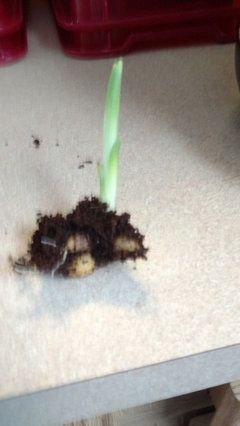
this is after I took a clump of 3 and planted indoors under full spectrum led. This after 3 weeks.signet_gw(6b)
7 years agoNoah . looking at your pics it would appear you are growing lilies ( bulbs) not daylilies ( roots) .
HU-781689113
5 years agoI have been dividing and relocating some of my daylilies recently. One day a couple weeks ago I looked at the pile of "roots" "tubers" "rhizomes" whatever you call the little nodes on the roots that had broken off (no part of crown), and thought " such a waste if they sprout." I looked on-line and from all I read, the answer was that these would not grow into a plant. I decided to try an experiment. I gathered them all, probably a couple cups worth, dusted them in rooting medium, and planted them all together in a large pot. We have had good rain at the right times, and I watered when the soil in the pot was dry. Last night we had a lot of rain, with flood warnings. What wasn't there yesterday is a daylily sprout today, about a half inch tall. No I won't know the name or names until or if I get blooms. But I am encouraged...and I believe it is possible.
organic_kitten
5 years agolast modified: 5 years agoThat has to be what happened when I dug up and either gave away or discarded daylilys on a couple of occasions. Even carefully trying to avoid any piece left.I have replacement plants grow, (Helix and The Secret of Contentment) But, the little bulblets in the photo do not look like daylily oots.
kayHU-781689113
5 years agoIf Noah has lily bulbs, perhaps rain lilies? And maybe they are some early spring bulbs such as snowdrop.
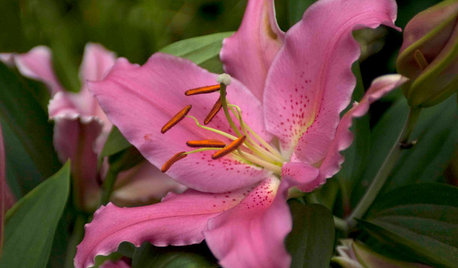
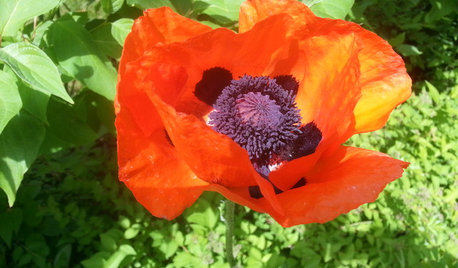






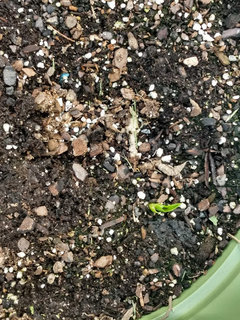
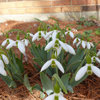


Ed